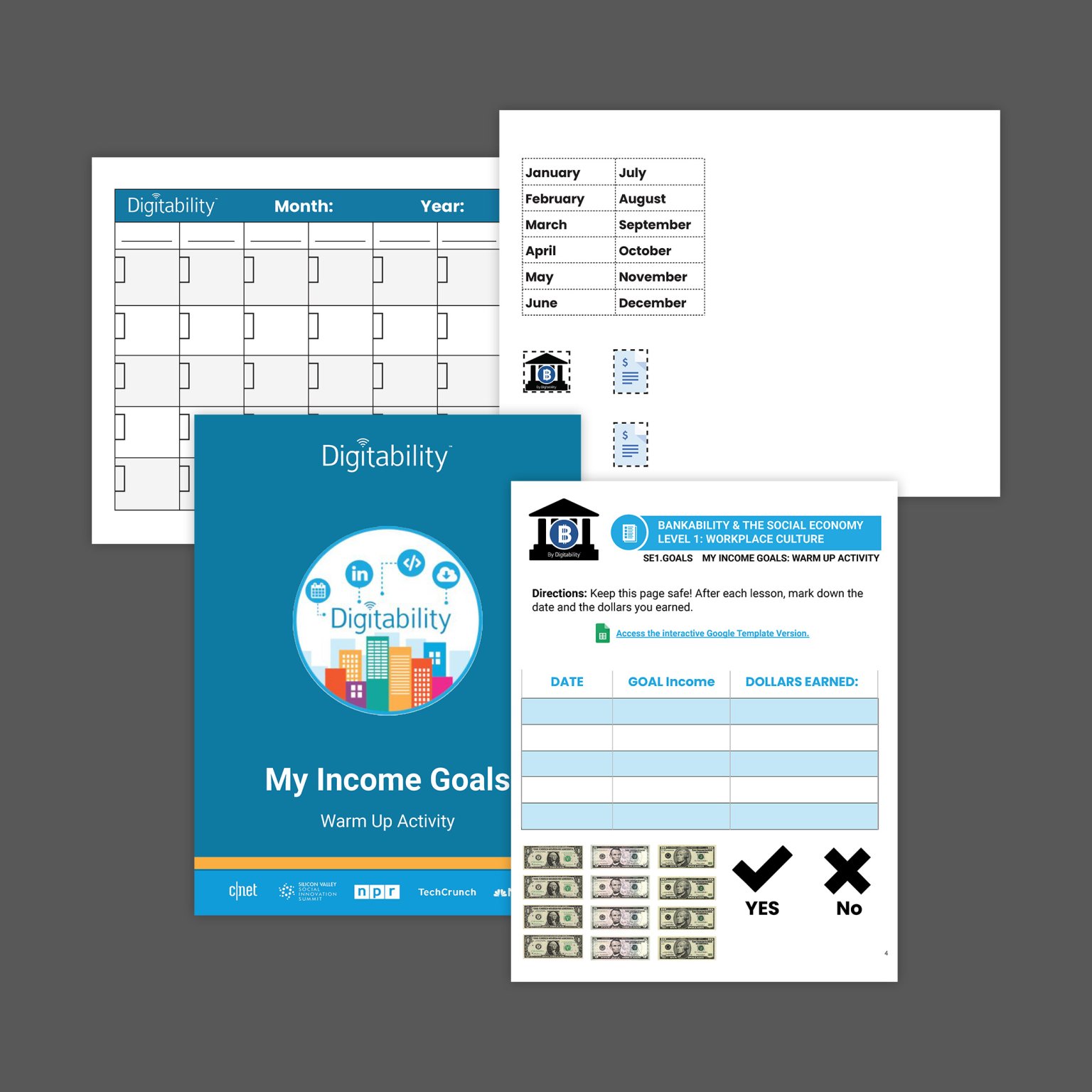Modifying Instruction During the Warm Up

No Two Students are the Same; Neither are their IEP Goals
Each student requires something different when it comes to their list of IEP goals. Every day teachers are charged with finding ways to engage, support, motivate and differentiate for each of their students.
Digitability has organized strategies for streamline evidence-based practices for any given classroom with a wide-range of student needs including varying cognitive abilities, expressive and receptive language, self-regulation skills, and age-appropriate behavior. It’s a tall order for life skills teachers to manage.
Get Your FREE Quote Today!
Overview of the Warm Up
During the Warm Up (and throughout instruction), teachers use differentiation strategies and leveled resources, which are included in each lesson plan, to increase expressive and receptive language based on individual student needs.
Goals for Financial Literacy and Workplace Behavior
The first part of the Warm Up asks students to set financial goals for themselves. Students will recall how many dollars they earned on the previous day and answer how many dollars they want to earn today.
The teacher will use the scripted language from the lesson plan “For a Participation Dollar, (Student Name) how much money did you earn yesterday?” And “For a Participation Dollar, raise your hand and tell me how many dollars you would like to earn today?”
A variety of visual supports are provided to help students with limited expressive and receptive language. These differentiated resources are designed to ensure that every student is able to be meaningfully included in the lesson, regardless of their ability level. The differentiated resources should be used to decrease assistance over time. Selecting an appropriate leveled resource allows the teachers to minimize prompts provided to students and increase independence.
In addition to financial literacy and setting goals, teachers will use the warm up to activate and recall prior knowledge, increase motivation and task attendance.
Meet the Student Personas
Note: The following personas are meant to illustrate a range of cognitive, communicative and behavioral needs for a wide-range of learning styles. These personas were created to help teachers identify the characteristics and associated strategies for their students needs.

Advanced Tier 1 Student: Drew can read, write, and comprehend paragraphs. Academically, he is one year below grade level. He is reinforced by getting time to use his phone during school. Drew has low motivation to complete assignments. He has difficulty with self-regulation and responsible decision making. He also has difficulty with impulse control. Drew is charismatic and his peers are drawn to him, giving him the potential to be a leader.

Tier 1 Student: Marcus can speak in 2-3 sentences and is able to read and comprehend paragraphs. He is reinforced by watching videos on Youtube. Marcus’ behaviors that impede learning include interrupting and complaining. He consistently is helpful with other students in the class and is a strong problem solver.

Tier 2 Student: Abbey can speak in 4-5 word utterances, and she is able to read with little comprehension. Abbey is reinforced by listening to music. She has some behaviors that interfere with learning, such as making off topic comments and teasing others. Abbey tends to perseverate on fairies and princesses, which contributes to her off topic comments. However, Abbey is an active participant in lessons and frequently shares with her peers.

Tier 3 Student: Jonathan is primarily nonverbal, he uses a communication device inconsistently, and knows some signs. He is not yet reading and has limited listening comprehension. Jonathan is reinforced by playing computer games. He demonstrates behaviors that interfere with learning, such as aggressive behavior and not following directions. However, Jonathan consistently greets others and likes to participate in lessons.
Strategies for an Advanced Tier 1 Student

Advanced Tier 1 Student:
Functional Academics: Can read, write, and comprehend paragraphs; Academically, he is one year below grade level.
Language: Age-appropriate
Reinforcers: Time to use his phone during school
Behavior: Low motivation to complete assignments. Difficulty with self-regulation and difficulty with impulse control.
Strengths: Charismatic and his peers are drawn to him, giving him the potential to be a leader.
During the Warm up: The teacher prompts students asking, For a participation dollar, who can tell me how much money they earned yesterday? Given Drew’s tendency for low motivation, he calls out a complaint: “This is dumb. I don’t want to do this.”
Strategies for Addressing Complaining
- Drew is avoiding an undesirable task by exhibiting attention-seeking behavior. If the teacher immediately response to this behavior, it may be reinforcing to Drew and increase his use of complaints to avoid work or seek attention in the future. Instead, the teacher can use is Positive Narration and draw attention to a student who is following directions and the command. “Let's see. Abbey has her hand up and is ready to share and earn a participation dollar. Go ahead Abbey."
- After reinforcing Abbey's completion of the command, the teacher can provide another opportunity for Drew to engage while reminding him that his participation provides him with rewards. "Abbey earned $15 yesterday. Nice work participating and earning a participation dollar! Who else would like to share and earn a participation dollar toward their future purchases?"
- The teacher can address Drew more directly to engage him in the activity. "Abbey earned $15 yesterday. Nice work participating and earning a participation dollar! Drew, for a participation dollar that you can use toward cell phone time, how many dollars did you earn yesterday?"
- The teacher can also use a supplemental resource and their physical presence to engage Drew in this activity, creating an opportunity to provide positive reinforcement with some support. Using a Digitability T3 Supplemental resource, the teacher can walk over to Drew's desk holding up a sheet with numbers that represent how much money Drew earned. "Drew, for a participation dollar, how much money did you earn yesterday?
- Any time Drew participates, the teacher should provide immediate feedback using the embedded Digitability language formulas.
repeat the answer + describe the behavior + deliver consequence
"Drew said he earned $10 yesterday, great job earning a Participation Dollar!"
- In Level 2 of Digitability's Workplace Behavior Unit, students will identify and practice both the behaviors that will support their success in the workplace, as well as those behaviors that can be perceived as problematic. In these lesson plans, Digitability will explicitly explain how complaining impacts the workplace and depict strategies for developing self-regulation skills and a self-advocacy plan. In this level of Digitability, the teacher can utilize the Social Economy to assign a $1 fee for complaining to help Drew analyze the frequency of this behavior and strengthen his strategies for self-regulation. To learn more, contact our team.

- What is an Extinction Burst? It is important to understand that with some interventions the behaviors may seem to increase in frequency, intensity or duration before they begin to decrease. This is called an extinction burst. Evidence-based practices embedded in Digitability's Social Economy are tools that should be used consistently in order to be effective. It won't be a one-and-done solution!
Strategies for a Tier 1 Student

Tier 1 Student:
Functional Academics: Can read and comprehend paragraphs
Language: Can speak in 2-3 sentences
Reinforcers: Watching videos on Youtube
Behavior: Interrupting and Complaining
Strengths: Consistently helpful with other students, strong problem solver
During the Warm up: The teacher will ask "For a Participation Dollar, how much money did you earn yesterday?" Marcus should be prompted to refer to his “My Income Goals” worksheet to recall how many dollars he earned the previous day, if needed, and he should then write his goal income for the day on his worksheet. Marcus should earn a Participation Dollar for each question he answers.
Strategies for Prompting a Tier 1 Student

Gesture Prompt: The teacher motions or points toward Marcus’ “My Income Goals” worksheet.
- Another strategy that the teacher can use is Positive Narration. The teacher could say “Drew referred to his 'My Income Goals' worksheet to recall how many dollars he earned yesterday. Who else can use their resources to share how many dollars they earned yesterday, to earn a Participation Dollar?"
- After using positive narration and prompting, Marcus provides his answer. To reinforce him, the teacher will use the language formula: repeat the answer + describe the behavior + deliver consequence. This may look like “Marcus said he earned $12 yesterday, great job earning a Participation Dollar!"
- Whenever Marcus answers questions while demonstrating appropriate behavior, the teacher should provide immediate feedback using the embedded Digitability language formulas.
repeat the answer + describe the behavior + deliver consequence
"Marcus said he earned $12 yesterday, great job earning a Participation Dollar!"
- In Level 2 of Digitability's Workplace Behavior Unit, students will identify and practice more behaviors in the workplace that will support their success in the workplace as well as those behaviors that can be perceived as problematic. In these lesson plans, Digitability will explicitly explain how complaining impacts the workplace and strategies for developing self-regulation skills and self-advocacy plans for the workplace. To learn more, contact our team.
Strategies for a Tier 2 Student

Tier 2 Student:
Functional Academics: Can read with little comprehension, some writing skills, low IQ
Language: Speaks in 4-5 word utterances
Reinforcers: Listening to music
Behavior: Making off-topic comments due to perseverating on fairies and princesses, teasing others
Strengths: Actively participates in lessons, frequently shares with peers
During the Warm up: The teacher will ask "For a Participation Dollar, how much money did you earn yesterday?" Abbey should be given the opportunity to verbally respond to the Warm Up questions while referring to her “My Income Goals” worksheet. If additional support is needed, Abbey can be prompted to use the numbers Image Exchange Cards to either point to the number that corresponds to her answer or exchange that number card. She can then write or trace her goal income for that day on her worksheet. While answering, Abbey may turn to a peer and begin to tease them, by sticking her tongue out at them.
Strategies for Addressing Teasing
- “Abbey, remember, teasing classmates will not earn dollars, and you need dollars to buy time to listen to music. Let's try again to answer nicely."

A visual prompt could be used by providing Abbey with an envelope to keep her dollars in that includes a picture of music on the front. This would serve as a reminder to Abbey that her dollars can be used to purchase music time.


A gestural prompt could be used by the teacher pointing or motioning toward the visual of the music on her envelope.
- The teacher could also use Positive Narration: “Marcus answered his question while also being kind to his classmates. He earned a Participation Dollar! Who else would like to earn a Participation Dollar?"
- When Abbey answers without teasing, the teacher will use the language formula: repeat the answer + describe the behavior + deliver consequence. This may look like "Abbey said she earned $8 yesterday, great job earning a Participation Dollar!"
- Any time Abbey participates without teasing, the teacher should provide immediate feedback using the embedded Digitability language formulas.
repeat the answer + describe the behavior + deliver consequence
"Abbey said she earned $8 yesterday, great job earning a Participation Dollar!"
- In Level 2 of Digitability's Workplace Behavior Unit, students will identify and practice more behaviors in the workplace that will support their success in the workplace as well as those behaviors that can be perceived as problematic. In these lesson plans, Digitability will explicitly explain how complaining impacts the workplace and strategies for developing self-regulation skills and self-advocacy plans for the workplace. To learn more, contact our team.
Strategies for a Tier 3 Student

Tier 3 Student:
Functional Academics: Not yet reading, limited listening comprehension, low IQ
Language: Primarily nonverbal, uses a communication device inconsistently, knows some signs
Reinforcers: Playing computer games
Behavior: Aggressive behavior, not following directions
Strengths: Consistently greets other, enjoys participating in lessons
During the Warm up: The teacher will ask "For a Participation Dollar, how much money did you earn yesterday?" Jonathan should be given the opportunity to respond to the Warm Up questions on his communication device or using the numbers Image Exchange Cards. If more support is needed, the teacher can give Jonathan Yes/No Cards and can ask him “Did you earn 12 dollars yesterday,” allowing Jonathan to respond by pointing or exchanging a yes or no. Jonathan may not follow directions and not give a response to the questions. The teacher will have to build his motivation and prompt him toward the correct answer. Once he makes a selection, he can write, trace, or match his goal income for the day on his worksheet.
Strategies for Addressing Not Following Directions
- To build Jonathan's motivation to follow directions, the teacher should remind him of the expected behavior and the reinforcement he will receive. "Jonathan, you earn Participation Dollars for answering our Warm Up questions. When you have enough dollars, you can buy time to play computer games. Let's try again, how many dollars did you earn yesterday?"
- Verbal, Gesture, Visual Prompts: While providing the visuals of the Yes and No cards, the teacher can say "Jonathan, look at your 'My Income Goals' sheet, did you earn $12 yesterday," while simultaneously pointing to the corresponding answer card.

Positional Prompt: When asking the question, the teacher can display the Yes and No answer cards on Jonathan’s desk with the correct card closer to Jonathan, and the incorrect answer farther away.

Model Prompt: The teacher can model the process of recalling how much money he earned yesterday by saying "Let's look at your 'My Income Goals' sheet from yesterday. I see that you recorded that you earned $15 yesterday. So, did you earn $12 yesterday?"

Physical Prompt: The teacher can take Jonathan’s hand and move it toward the correct answer card.
- The teacher could also provide Jonathan with a visual that shows dollars equals computer games, to increase his motivation to earn dollars.
- After prompting Jonathan toward the correct answer, the teacher will use the language formula: repeat the answer + describe the behavior + deliver consequence. This may look like "Jonathan said he earned $15 yesterday, great job earning a Participation Dollar!"
- Any time Jonathan participates with appropriate behavior, the teacher should provide immediate feedback using the embedded Digitability language formulas.
repeat the answer + describe the behavior + deliver consequence
"Jonathan said he earned $15 yesterday, great job earning a Participation Dollar!"
- In Level 2 of Digitability's Workplace Behavior Unit, students will identify and practice more behaviors in the workplace that will support their success in the workplace as well as those behaviors that can be perceived as problematic. In these lesson plans, Digitability will explicitly explain how complaining impacts the workplace and strategies for developing self-regulation skills and self-advocacy plans for the workplace. To learn more, contact our team.
If you need additional resources or assistance in differentiation, reach out to your coach!








